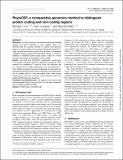PhyloCSF: a comparative genomics method to distinguish protein coding and non-coding regions
Author(s)
Lin, Michael F.; Jungreis, Irwin; Kellis, Manolis
DownloadLin-2011-PhyloCSF.pdf (1.078Mb)
PUBLISHER_CC
Publisher with Creative Commons License
Creative Commons Attribution
Terms of use
Metadata
Show full item recordAbstract
Motivation: As high-throughput transcriptome sequencing provides evidence for novel transcripts in many species, there is a renewed need for accurate methods to classify small genomic regions as protein coding or non-coding. We present PhyloCSF, a novel comparative genomics method that analyzes a multispecies nucleotide sequence alignment to determine whether it is likely to represent a conserved protein-coding region, based on a formal statistical comparison of phylogenetic codon models.
Results: We show that PhyloCSF's classification performance in 12-species Drosophila genome alignments exceeds all other methods we compared in a previous study. We anticipate that this method will be widely applicable as the transcriptomes of many additional species, tissues and subcellular compartments are sequenced, particularly in the context of ENCODE and modENCODE, and as interest grows in long non-coding RNAs, often initially recognized by their lack of protein coding potential rather than conserved RNA secondary structures.
Date issued
2011-07Department
Massachusetts Institute of Technology. Computer Science and Artificial Intelligence Laboratory; Massachusetts Institute of Technology. Department of Electrical Engineering and Computer ScienceJournal
Bioinformatics
Publisher
Oxford University Press
Citation
Lin, Michael F., Irwin Jungreis, and Manolis Kellis. “PhyloCSF: a Comparative Genomics Method to Distinguish Protein Coding and Non-coding Regions.” Bioinformatics 27.13 (2011): i275–i282. Web.
Version: Final published version
Other identifiers
PMC3117382
ISSN
1460-2059
1367-4803